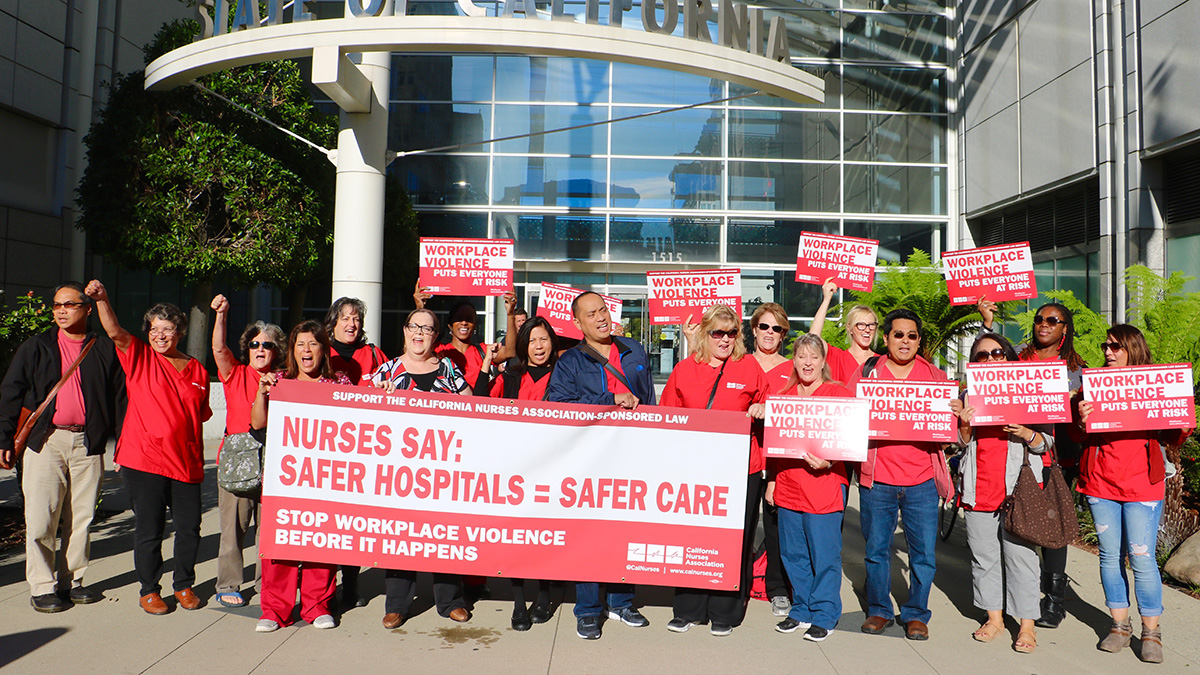Workplace violence prevention tips

By Chuleenan Svetvilas
National Nurse Magazine - July | August | September 2021 Issue
The first thing you have to do is stop assuming that workplace violence is part of the job, said Joanne Imwalle, RN at Kaiser South Sacramento and a longtime advocate for workplace violence prevention. Robin Cole, RN at the same facility, agrees, stating, “We really need a culture shift.”
“It’s up to all of us, not just nurses, to say, ‘No, workplace violence is not OK,’” said Renee Stalker, RN at Kaiser Roseville. “It’s not part of my job to be hit, screamed at, or threatened.”
“Number two, is recognizing when patients or family members are escalating,” said Imwalle. “Threat mitigation is good for both sides so the patient and the nurse are safe.”
Here’s advice from five Northern California Kaiser nurses who have been working on mitigating and preventing workplace violence at their facilities.
Communicate
“It is vital to have communication between nurses to keep each other safe,” said Thuy Ho, RN at Kaiser Roseville. “Within each unit, share your concerns with your supervisor. Keep each other informed about what is happening. We all want to make sure we work in a safe environment.”
Start with the unit and if there’s a professional performance committee (PPC), bring up the issue and see if you can track the information and follow up. “If you work in silos, you only know what happening in your unit,” noted Ho. “This is why the PPC is so important, so you know what is going on in the whole hospital.”
Report and track
Reporting is important so you can hold employers accountable. If you are involved in an incident, use your facility’s protocol to report it and then follow up with management and facility administrators, advised Cole.
When incidents occur, it is essential to track them and find ways to mitigate or they will keep occurring. By collecting and tracking data, you can identify what type of incidents are happening as well as when and where they are happening in your facility. With that information, you can take action to prevent them from recurring. “Chart it, document it, acknowledge that the incident happened and realize that we don’t have to tolerate this,” said Debra Rickford, RN at Kaiser South Sacramento.
Know the law
If you are in California, which has workplace violence prevention regulations enforced by Cal/OSHA, Renee Stalker, RN at Kaiser Roseville, recommends that nurses read the text of the Cal/OSHA Workplace Violence Prevention in Healthcare Standard. “Become familiar with it and understand what your facility should be working towards to comply with the law,” said Stalker.
Minnesota nurses have a law that requires hospitals to conduct workplace violence training for all health care workers annually and for new employees. The training must include safety guidelines for responding and deescalating violent incidents, ways of identifying potential violence or abuse, and hospital plans for responding to incidents and for violence prevention.
If you are outside of California, support the federal bill to create a national standard, the Workplace Violence Prevention for Health Care and Social Service Workers Act, H.R. 1195. The bill passed the House in April 2021 and is moving forward in the Senate. This legislation is modeled on California’s landmark workplace violence prevention law. “Read the federal bill and start mobilizing,” advised Stalker. “Strategize your fight for better regulations.”
Follow up and organize
“Once you start, be persistent and work within the parameters of your facility,” said Cole. “If you don’t see any follow through or any changes to mitigate workplace violence, then organize!”
Cole recommends doing an action, such as creating a petition and getting other nurses involved. “Use whatever means you have,” said Cole. “Get committees involved, reach out to the local community to get support there.”
If you don’t have a professional performance committee of nurses, organize to collectively prevent workplace violence. “Organizing is the only way we’re going to do stop workplace violence,” said Imwalle. “By staying together, we not only have made the conscious decision that it’s not part of our job, but the employer has a legal and moral responsibility to keep us safe. Collectively, we have to come together and stop the violence.”
Chuleenan Svetvilas is a communications specialist at National Nurses United.